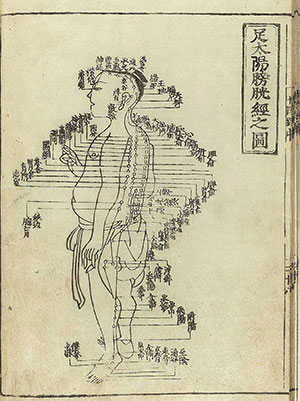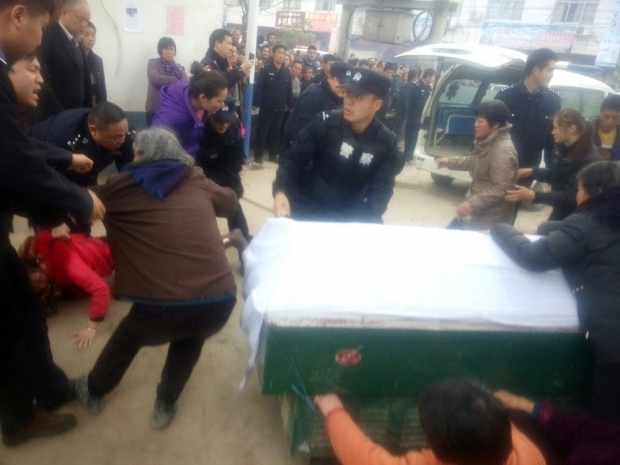On the morning of March 16, 48-year-old Huang Shunfang went to her local hospital located in Fanghu Township in the central Chinese province of Henan. Her doctor diagnosed her with gastritis, gave her a dose of antacids through an IV, and sent her on her way. Huang died suddenly that afternoon. In the hours after her death, Huang’s family went to the hospital for an explanation and was told by the hospital leadership that “the hospital is where people die,” according to a witness’ account of the incident. Incensed, Huang’s family visited the local public security bureau and the health bureau, both to no avail. Four days later, on March 20, after rejecting the hospital’s offer of compensation of RMB 5,000 ($800), the family placed Huang’s corpse outside the gate of the hospital in protest. Soon, over a hundred policemen swooped in to take the body away, beating and detaining Huang’s relatives who tried to resist them.
A week earlier, at noon on March 9, during a forced residential demolition operation orchestrated by the township government in Jiangkou Township, Anhui province, 37-year-old Zhang Guimao died when his chicken coop collapsed on him. That afternoon, Zhang’s relatives, along with more than a hundred villagers, carried Zhang’s body into the township government office compound to demand an explanation. At midnight that day, all the streetlights suddenly went dark. Around two hundred riot police carrying shields appeared on the scene to take the body away to the crematorium, detaining at least six people in the process.
“Taishi kangyi,” or “carrying the corpse to protest,” is a practice with deep roots in Chinese history. Since late imperial times, people have employed it when judicial systems failed to provide a reliable channel of redress for injustice. These days, corpses are dragged into all manner of disputes involving medical malpractices, forced housing demolitions, vendor’s tussles with local patrols, and compensations for workplace accidents. When an accidental death occurs, citizens use the corpse to draw attention and invite sympathy from the wider public, all in an effort to put pressure on the authorities and to render a just outcome. This “highlights the distrust people feel about autopsies or investigations conducted by government organs and China’s justice system,” says Teng Biao, a civil-rights lawyer and visiting scholar at Harvard Law School. “Especially with the rise of social media in the past ten years or so, families of the dead can post photos or videos online. The rapid spread of such information can turn up the heat on local governments.”
It’s that heat that perhaps has driven Chinese law enforcement to ever-more coordinated and deliberate attempts to curb corpse-keeping. A common scene across China today pits families, friends, and local residents barricading a dead body in concentric circles against police, often numbering in the hundreds and armed with batons and shields. The police break through the crowds to reach the corpse and “snatch” it. Local governments, following standard operating procedures developed in recent years, apply this practice known as “qiangshi,” or “snatching the corpse,” when a case of accidental death occurs. “The authorities’ rapid and forceful response focusing on the dead body demonstrates a model of preemptive intervention and suppression,” says Wu Qiang, a professor of political science at Tsinghua University.
The most dramatic qiangshi clash in recent years followed the death of 24-year-old Tu Yuangao in Shishou, Hubei province. On June 17, 2009, Tu was found dead outside the hotel where he was working as a chef. Police quickly declared he had committed suicide, but the circumstances surrounding the death led Tu’s family to believe he was murdered. His relatives moved Tu’s body into the hotel lounge. Over the next three days, tens of thousands of local residents joined with Tu’s family to guard the body. Video clips posted online show protestors beating back waves of armed police whose numbers swelled into the thousands. Protesters also vandalized and toppled fire trucks and police vehicles. Tu’s family members, armed with two buckets of gasoline and more than a dozen gas tanks, vowed to protect Tu’s body to the death. Eventually, the hotel was set on fire and Tu’s family was forced to flee. After about 80 hours of fierce fighting, the government finally persuaded the family to move Tu’s body to a funeral parlor. On June 21, medical experts performed an autopsy on Tu, concluding the cause of death was “a fall from a height.” Four days later, Tu’s body was cremated.
According to a professor who has worked with the Chinese government on “internal security maintenance” but who asked not to be named because he was not authorized to speak publicly on this issue, Chinese authorities believe that corpses themselves can cause unrest. “After the Shishou incident in 2009, the Central Politics and Law Commission [the Chinese Communist Party organ that oversees the internal security forces and the court system] had a training video made for its police forces. In the video, it was said that the reason that the Shishou incident had escalated was due to the corpse, ‘the source of excitement,’ not having been removed in a timely manner. Since then, in all mass incidents [the official term for protests, riots, and other forms of social disorder in China] that involve death, removing the corpse became the number one priority.”
Several local government reports have also emerged online discussing the importance of quickly taking possession of corpses in these types of cases. A government official in Guang’an, Sichuan province writes, “The corpse is the most sensitive… People who have ulterior motives use the dead body to pressure the government… Onlookers, out of curiosity and sympathy, encircle the corpse forming a large crowd. If the corpse is not removed in time, a mass incident can break out at any time... [We must] ensure the corpse be moved to the funeral parlor without any conditions.” A report written by traffic police officers in Yongzhou, Hunan province, similarly notes that, “Empirical evidence shows the majority of traffic-accident-induced mass incidents are due to the corpse’s not being removed from the scene… After confirming the deaths, traffic police departments…should move the corpse to a funeral parlor as soon as possible.”

But why is the dead body a “source of excitement”? One reason may have to do with tradition. In China, when someone dies of unnatural causes, his or her corpse is often tied to the idea of “yuan,” or “being wronged.” In the opening of the Song dynasty classic The Washing Away of Wrongs, published in 1247 and considered the world’s earliest documentation of forensic science, author and coroner Song Ci explains that the whole point of an accurate autopsy of an unnatural death is to “xiyuan zewu,” or “wash away wrongs and oblige others.” Today, popular TV dramas in China such as Witness to a Prosecution, which tells the story of Song Ci; Amazing Detective Di Renjie; or Young Justice Bao popularize these ideas. A typical narrative is as follows: A dead body is found. After a meticulous investigation, the protagonist solves the case. The story ends when yuan is “washed clean,” wrongs have been righted, and justice has been served.
As sociologist and professor at Shanghai University of Political Science and Law Zhou Songqing writes, “In a mass incident, the corpse of a death in which the cause is unclear becomes a symbol. In its simple and even crude way, it is the embodiment of injustice and persecution. It arouses sympathy among the people surrounding [it].”
The practice of using corpses to protest and seek retribution can be traced as far back as the Ming and Qing dynasties, when official parlance referred to it as “tulai,” or “conspiring to entrap.” Ming and Qing dynasty histories refer to how corpses were used to threaten or incriminate innocent people for financial or other gains. Both the Ming and Qing dynasties had specific laws punishing such conduct. The Qing Code, or daqing liuli, stipulates that those using the corpses of parents or grandparents for extortion should be sentenced to be flogged 100 times and serve three years in prison. Official narratives undoubtedly undermine the cases of those who had no choice but to employ the corpse as a way to have their grievances heard and addressed. Nevertheless, it attests to the prevalence and even effectiveness of such a practice. As historian Melissa Macauley nicely summarizes in her book Social Power and Legal Culture: Litigation Masters in Late Imperial China, the dead body is “one legal tool of empowerment.”
In modern times, while the availability of information about disputes has increased and resulted in the more accurate recounting of death cases, an old practice continues to add weight in strengthening one’s case. In a well-known incident from Minquan county, Henan province in 1988, the local township government detained and beat peasant Cai Fawang who refused to hand over tax grain. Cai committed suicide by hanging himself in front of the police station. Cai’s wife and son first went to the township government office and put the dead body in the township Party Secretary’s office living quarters for 13 days. After the corpse began to decay and smell, they then placed the corpse in a coffin and parked the coffin in the yard of the government office building for nine months. A journalist who visited the village at that time wrote, “The township government was basically in exile. [They] tore a hole in the wall [of their office] to come and go by.” The powerful presence of the corpse, a constant reminder of injustice and suffering, clearly had an effect on the local government employees.
Times have changed. It is difficult to imagine in today’s China that police would allow a dead body to remain out in the open for months, even letting it “take over” a local government office. As China’s economy continues to grow, social tensions have also mounted, with the number of mass incidents soaring in recent years. The Chinese government has responded with measures of its own, committing more money to internal stability maintenance than on the military in 2012 and 2013 (the 2014 public security budget was not publicized). Stymying these demonstrations to prevent escalation to major social unrest is now paramount.
Yet ironically, the Chinese government’s “obsession with social stability” fuels instability because discontented citizens, aware that local authorities want to avoid all instances of social unrest, are effectively incentivized to employ more disruptive measures to “game the system,” says Carl Minzner, professor of law at Fordham Law School. “By threatening to create scenes of social unrest, like using dead bodies to protest, some people try to wring concessions from the authorities. Often, these are calculated decisions. And sometimes they produce results—such as higher monetary compensation—regardless of the underlying legal merit of the grievance.” The local authorities, Minzner adds, “simply are desperate to get protestors off the streets.”




